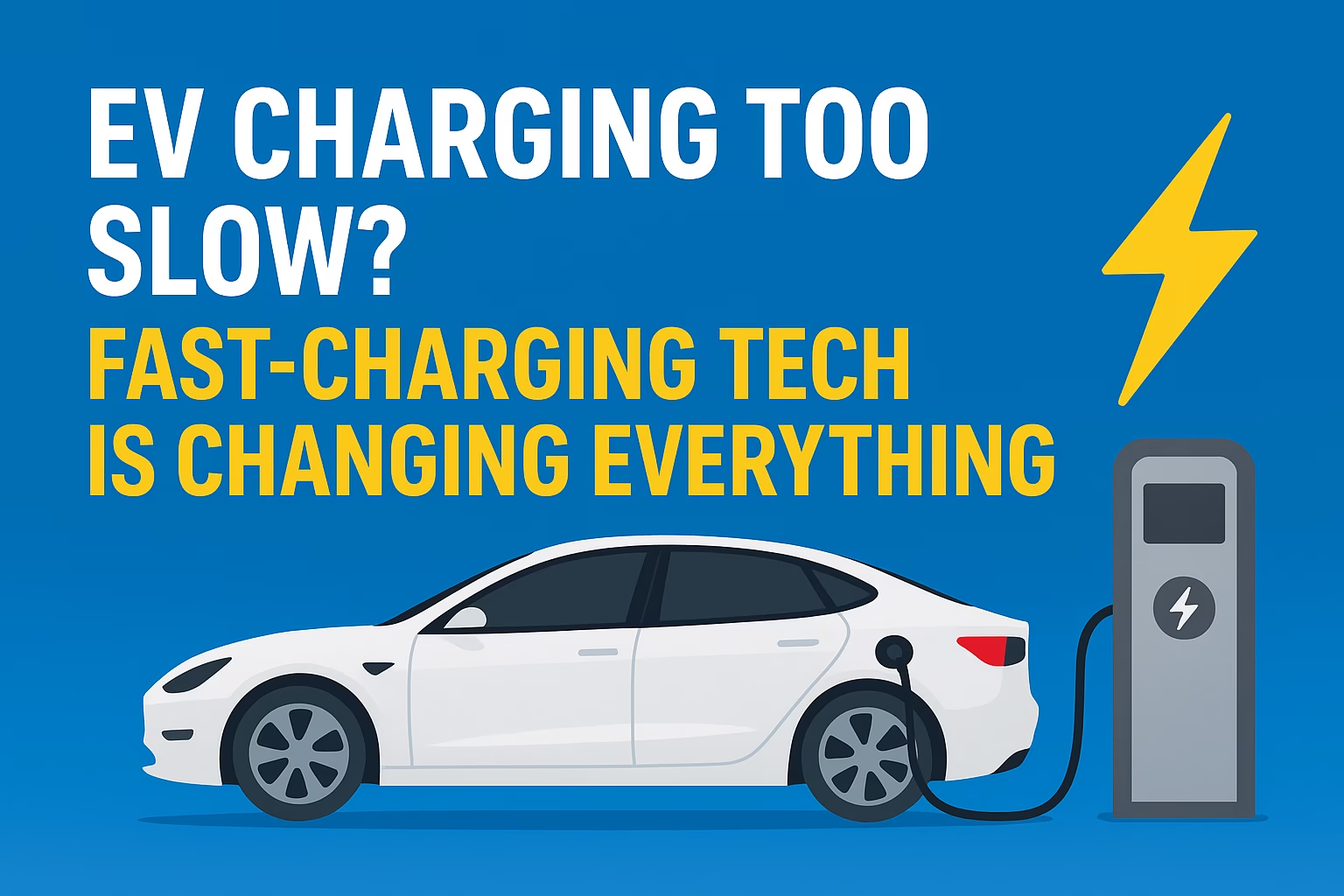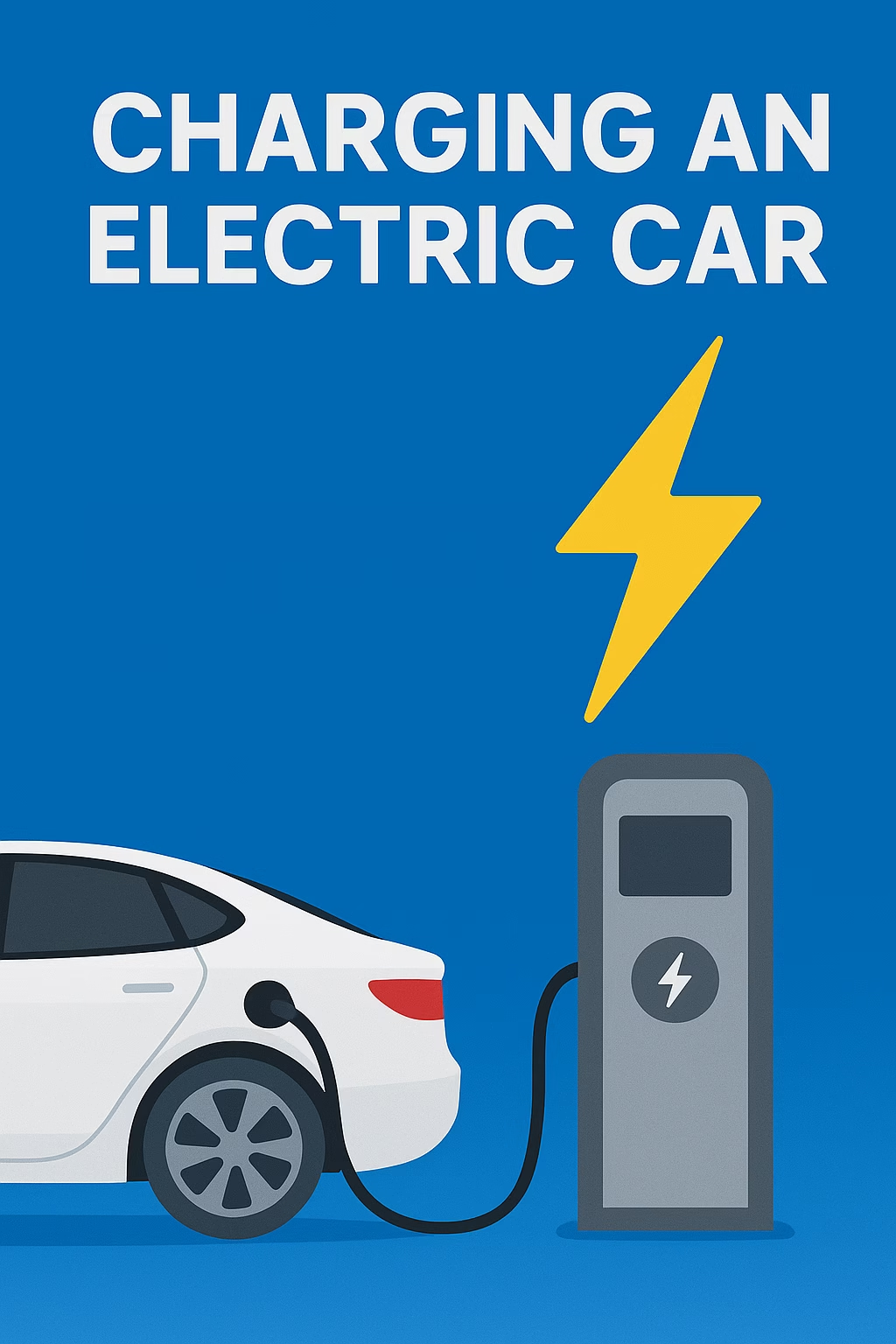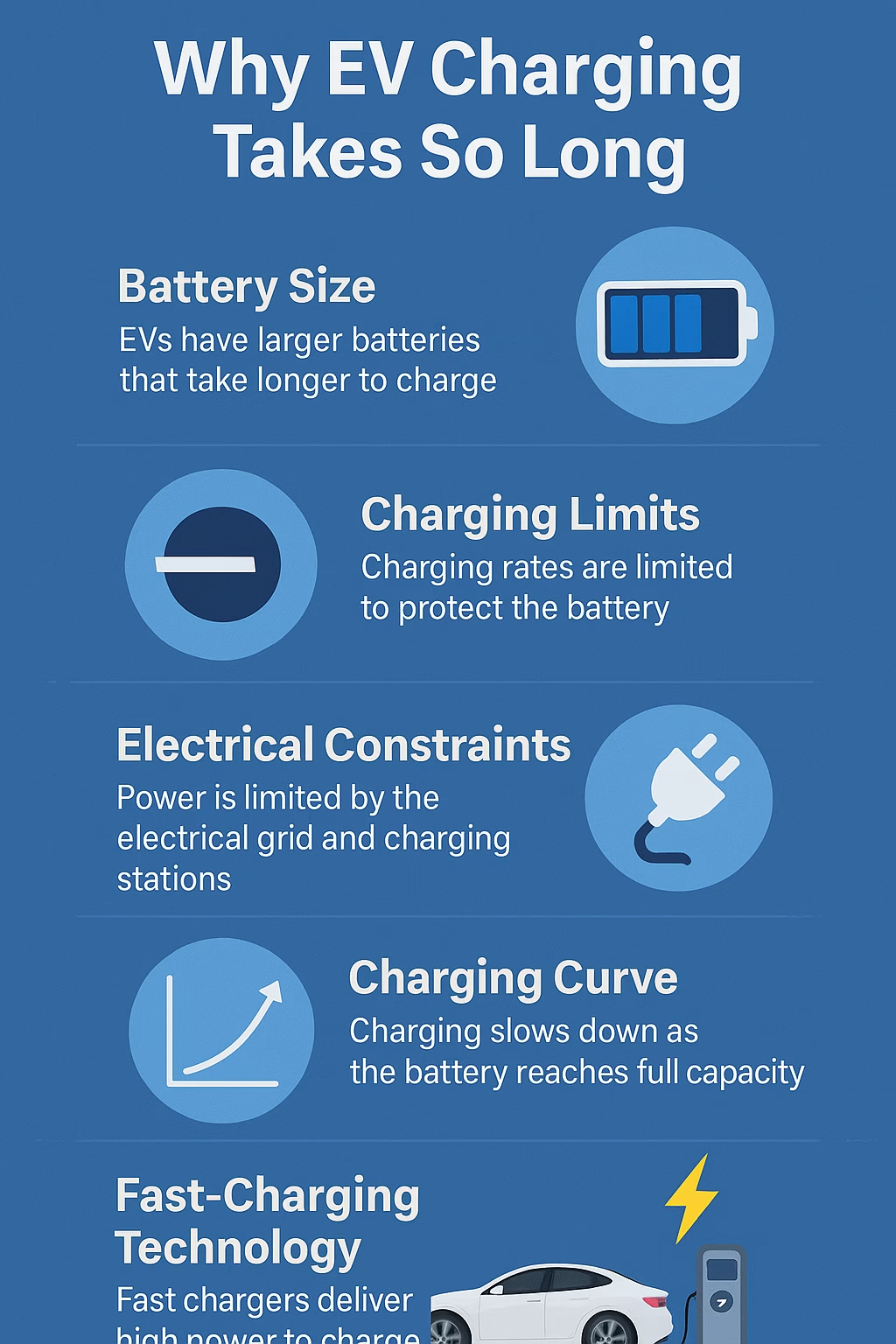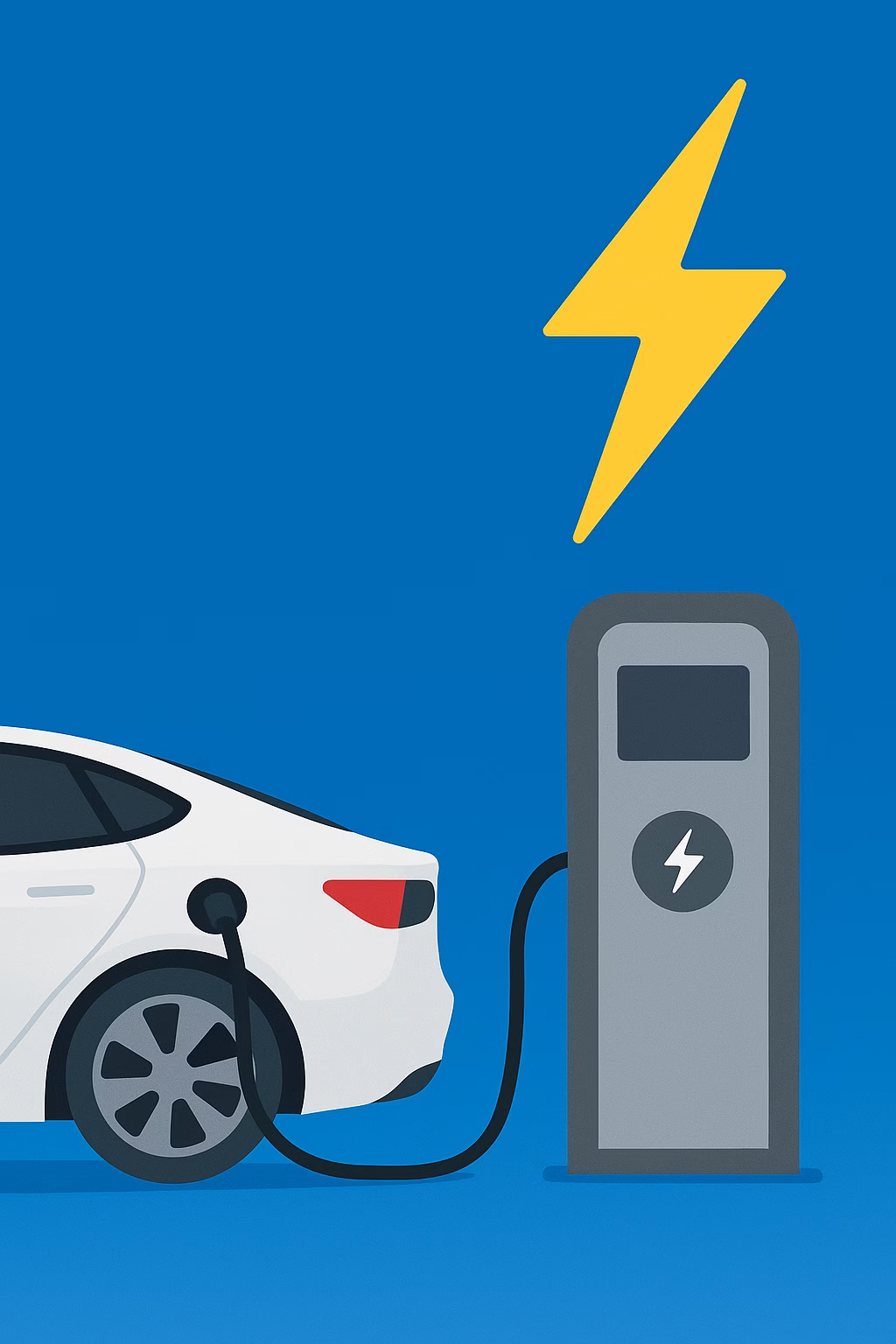⚡ The Growing Question: Why EV Charging Takes So Long?

If you’ve ever stood next to your electric car wondering why EV charging takes so long, you’re not alone. As electric vehicles (EVs) become more common, this question is asked by almost every new EV owner. While petrol or diesel refueling takes just a few minutes, EVs can take anywhere from 30 minutes to several hours. But why does this happen?
To understand the answer, we need to dive into the science of batteries, charging speeds, and how technology is working to make this process faster than ever.
🔋 Understanding the Basics: How EV Charging Works
Before we talk about why EV charging takes so long, it’s important to understand how charging actually happens.
An electric vehicle runs on a lithium-ion battery, similar to the one in your smartphone but much bigger. When you plug your EV into a charger, electricity flows from the grid into the battery, where it’s stored as chemical energy.
But here’s the key: charging a battery isn’t like filling a tank. Batteries take energy gradually, and the speed depends on several factors—battery capacity, charger type, and temperature. That’s one of the main reasons why EV charging takes so long compared to traditional refueling.
🕑 The Science Behind Slow Charging
So, let’s answer the core question — why EV charging takes so long from a scientific perspective.
Batteries are delicate systems. Charging them too quickly can cause overheating, shorten their life, or even damage internal cells. To prevent this, EVs are programmed to control the flow of current into the battery.
Charging happens in two stages:
- Constant Current Phase: The battery accepts charge at a fast, steady rate up to around 80%.
- Constant Voltage Phase: The final 20% slows down dramatically to protect battery health.
That’s why you’ll notice the last few percent of charging always feels painfully slow. This safety measure explains part of why EV charging takes so long, especially at the end of a session.
🏠 Level 1, Level 2, and DC Fast Charging Explained
Not all chargers are equal—and this plays a massive role in why EV charging takes so long for many users.
⚙️ Level 1 Charging:
- Uses a regular household outlet (120V).
- Adds roughly 4–5 km of range per hour.
- Great for overnight home charging, but very slow.
⚙️ Level 2 Charging:
- Uses a dedicated 240V supply.
- Adds around 30–40 km of range per hour.
- Common in public stations and ideal for daily use.
⚙️ DC Fast Charging (Level 3):
- Uses direct current instead of alternating current.
- Can charge up to 80% in 30–40 minutes.
- Requires special infrastructure and is more expensive to install.
So, if you’re using a regular plug, why EV charging takes so long becomes obvious—it’s simply not built for fast power transfer.
🌡️ Temperature and Battery Health – The Hidden Factors

Temperature plays a surprisingly big role in why EV charging takes so long. Batteries don’t like extreme heat or cold. When it’s too cold, the ions inside the battery move slower, reducing charging speed. When it’s too hot, the system slows down charging to prevent damage.
Modern EVs include thermal management systems to keep the battery at an ideal temperature, but these systems still need time to balance everything out. That’s another quiet reason why EV charging takes so long, especially in extreme weather conditions.
🚗 Why EV Charging Takes So Long – Real-World Examples
Let’s take two examples to make this clear:
- Tata Nexon EV (India):
- Home Charger (15A Plug): 8–9 hours for full charge
- Fast Charger: 50 minutes (0–80%)
- Tesla Model 3 (USA):
- Level 2 Home Charger: 8–10 hours
- Supercharger: 30–40 minutes (0–80%)
Even in premium EVs, you’ll notice the same pattern—fast till 80%, slow afterwards. The reason why EV charging takes so long isn’t just about power; it’s about protecting the battery’s lifespan.
RELATED : How Battery Swapping Could Cut Your EV Charging Costs by 40% in 2025
⚡ The Rise of Fast-Charging Technology
Now comes the exciting part — how technology is solving the problem of why EV charging takes so long.
Over the past few years, companies like Tesla, Tata, Hyundai, and BYD have been investing heavily in fast-charging innovations. The goal is simple: make charging times as close to petrol refueling as possible.
Here are the major breakthroughs:
1. Ultra-Fast DC Chargers (350 kW+)
Modern chargers can now deliver up to 350 kW of power, reducing charging time to 10–15 minutes for 80%. These chargers are becoming common on highways and major cities.
2. Solid-State Batteries
One of the biggest reasons why EV charging takes so long is liquid electrolyte resistance. Solid-state batteries replace that with a solid material, allowing higher current flow with minimal heat. Once commercialized, they could reduce charging time by 60–70%.
3. Battery Preconditioning
Some EVs now automatically preheat or cool the battery before reaching a fast charger. This ensures the battery is at the ideal temperature for rapid charging—another clever solution to why EV charging takes so long in real life.
4. AI-Powered Charging Management
AI is being used to analyze charging patterns, grid demand, and battery condition in real-time. This helps optimize power flow, ensuring the fastest and safest charge possible.

🌍 How India Is Tackling Slow EV Charging
In India, the biggest reason why EV charging takes so long is infrastructure. While urban centers are growing fast, rural and highway networks still depend on slower AC chargers.
However, the Indian government is actively addressing this with:
- FAME II Scheme: Supporting public fast-charging stations.
- Bharat DC001 Standards: Promoting compatibility across brands.
- Private Networks: Companies like Tata Power and Statiq are building 150+ kW chargers across major routes.
The future looks bright—once fast-charging stations are as common as petrol pumps, the question of why EV charging takes so long will fade away.
🔋 How to Reduce Your EV Charging Time Today
Until ultra-fast tech becomes widespread, you can still take steps to minimize charging time:
- Install a Level 2 charger at home.
- It’s the best investment for daily convenience.
- Charge between 20% and 80%.
- Avoid full charges unless needed; it saves both time and battery life.
- Use fast chargers only when necessary.
- Too frequent fast charging can wear out the battery.
- Precondition your car in extreme weather.
- Warm up or cool down the battery before charging.
- Plan routes using charging apps.
- Apps like PlugShare, Tata Power EZ Charge, or ChargeGrid can help find faster options nearby.
Following these tips can significantly reduce why EV charging takes so long for you personally.
🔮 The Future: Charging an EV in 5 Minutes?
Yes, it’s possible — and it’s closer than you think.
Several companies like StoreDot (Israel) and CATL (China) are developing super-fast batteries that can charge to 100% in under 5 minutes. These next-gen batteries use nanotechnology and advanced cooling materials to eliminate the key bottlenecks that explain why EV charging takes so long today.
Imagine plugging in your car, grabbing a coffee, and driving off fully charged — that’s the future fast-charging tech is racing toward.

🧠 Final Thoughts
So, why EV charging takes so long?
Because batteries are complex, charging infrastructure is still growing, and protecting the battery is as important as filling it fast.
But with fast-charging technologies, solid-state batteries, and AI-powered systems, the world is rapidly solving this challenge. What once took hours will soon take minutes.
In the coming years, why EV charging takes so long will no longer be a frustration—it’ll just be a reminder of how far EV technology has come.
FOLLOW US ON YOUR FAVORITE SOCIAL MEDIA TO GET LATEST UPDATES
